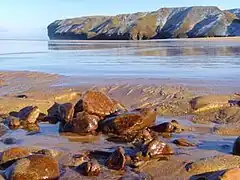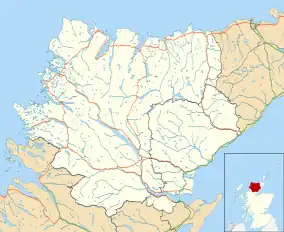Strathy
Strathy (from Scottish Gaelic Srathaidh 'place of the strath')[1] is a scattered community in Sutherland in the Scottish Highlands. The settlement emerged in the late 19th century as the north coast was populated by families forcibly displaced during the Highland Clearances.[2]
Strathy
| |
|---|---|
 Strathy | |
 Strathy Location within the Sutherland area | |
| OS grid reference | NC841650 |
| Civil parish | |
| Council area | |
| Lieutenancy area | |
| Country | Scotland |
| Sovereign state | United Kingdom |
| Post town | THURSO |
| Postcode district | KW14 |
| Dialling code | 01641 |
| Police | Scotland |
| Fire | Scottish |
| Ambulance | Scottish |
| UK Parliament | |
| Scottish Parliament | |
Strathy is on the north coast of Scotland, on the A836 road some twenty miles west of Thurso. The village itself includes at least three distinct areas:
- Strathy East (on the right-hand side when passing through the village in the direction of Bettyhill, accessed by two roads leading towards Strathy Beach),
- Strathy West (immediately to the south of Strathy East)
- Strathy Point.
These generally enclose the rest of the village, mainly comprising Steven Terrace. If welcoming signposts are taken to represent the limits of the village, Strathy is contained in these areas. However, some would say that Strathy also takes in the settlement of Baligill to the east, and also Brawl, Aultiphurst and Laidnagullin to the west, essentially the entire community found between the Baligill Burn and the Armadale 'Big' Burn.
The Church of Scotland at Strathy has a prominent position on the approach to the village from the east.
The lighthouse at Strathy Point was built in 1958; it was the first in Scotland to run on electricity, and last built with the intention of being manned. It ceased to operate in 2012.[2]

In the moorland at the south of the village is a limestone cross called "the priest's stone". It was described by Alexander Munro in 1900 as "absolutely unique among Scottish crosses", in that the deep cups at its four extremeties and centre seem to recall the "cups and rings" characteristic of similar pagan memorials, despite the monument's apparently Christian character. He speculated that it may date from the period of transition between paganism and Christianity in the area around the 7th century, although accepting that the absence of other evidence precluded any certainty.[3] Local legend has it that disturbing the stone will result in a storm.[2] Strathy's village hall contains a replica of the cross.
Climate
| Climate data for Strathy East (68 m asl, averages 1981–2010) | |||||||||||||
|---|---|---|---|---|---|---|---|---|---|---|---|---|---|
| Month | Jan | Feb | Mar | Apr | May | Jun | Jul | Aug | Sep | Oct | Nov | Dec | Year |
| Average high °C (°F) | 6.2 (43.2) |
6.6 (43.9) |
8.0 (46.4) |
10.2 (50.4) |
12.7 (54.9) |
14.6 (58.3) |
16.6 (61.9) |
16.6 (61.9) |
14.6 (58.3) |
11.6 (52.9) |
8.5 (47.3) |
6.6 (43.9) |
11.1 (51.9) |
| Average low °C (°F) | 0.8 (33.4) |
0.8 (33.4) |
1.7 (35.1) |
3.2 (37.8) |
5.2 (41.4) |
8.1 (46.6) |
10.1 (50.2) |
10.2 (50.4) |
8.2 (46.8) |
5.8 (42.4) |
3.2 (37.8) |
1.1 (34.0) |
4.9 (40.8) |
| Average precipitation mm (inches) | 100.4 (3.95) |
79.4 (3.13) |
82.3 (3.24) |
58.0 (2.28) |
55.3 (2.18) |
63.7 (2.51) |
70.5 (2.78) |
76.3 (3.00) |
96.8 (3.81) |
104.0 (4.09) |
115.5 (4.55) |
100.4 (3.95) |
1,002.6 (39.47) |
| Average rainy days | 18.6 | 15.9 | 16.2 | 12.8 | 12.0 | 12.6 | 13.7 | 15.1 | 15.5 | 17.6 | 18.5 | 17.6 | 186.1 |
| Mean monthly sunshine hours | 36.6 | 67.9 | 96.4 | 145.3 | 196.3 | 157.3 | 140.9 | 135.2 | 114.1 | 76.2 | 45.7 | 28.7 | 1,240.6 |
| Source: Met Office[4] | |||||||||||||
References
- Gaelic and Norse in the Landscape: Placenames in Caithness and Sutherland Archived 21 September 2011 at the Wayback Machine. Scottish National Heritage.
- Banks, John Yule. "History". Samhchair. Retrieved 18 May 2023.
- Munro, Alexander (30 November 1900). "Note on an Incised Stone Cross at Strathy, Sutherlandshire". Proceedings of the Society of Antiquaries of Scotland. 34: 252–254. doi:10.9750/PSAS.034.252.254. ISSN 2056-743X.
- "UK climate averages".